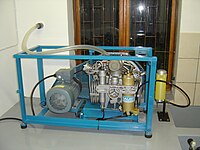
Photo from wikipedia
Abstract The growth of electricity usage in Thailand leads to a greater amount of flue-gas desulfurization gypsum (FGDG) to be stockpiled within the power plants. Similar to natural mined gypsum,… Click to show full abstract
Abstract The growth of electricity usage in Thailand leads to a greater amount of flue-gas desulfurization gypsum (FGDG) to be stockpiled within the power plants. Similar to natural mined gypsum, the disadvantages of FGDG for its utilization in structural materials are mainly due to its low compressive strength and slight water solubility. The present work aims to extend the applicability of FGDG as a structural material by calcining it into flue-gas desulfurization plaster (FGDP) and blending it with fly ash (FA) and ordinary Portland cement (OPC). The amounts of FGDP, FA and OPC were altered to search for the formulation that yielded the lower gypsum dissolution to improve the water resistance, compressive strength and minimize the risk of sulfate attack under the wet condition. This development will not only save the cost of landfill, add value to the abundant industrial byproducts, but also reduce the production cost of the construction material. The lowest gypsum dissolution and the highest compressive strength were achieved in the paste with FGDP: FA: OPC = 20 : 40: 40 at the water/binders ratio of 0.5, that also showed the Vicat initial setting time longer than 45 min. Only insignificant drop in the compressive strength was observed when it was cured by soaking in water, compared to curing by storing in a 100% relative humidity container. After adjusting either the amount of sand or superplasticizer to achieve the flow of 110 ± 5, the mortars with FGDP: FA: OPC = 20 : 40: 40 and 40 : 30: 30 from both adjustments could all attain the compressive strengths as required by ASTM C150. The insignificant compressive strength drop due to curing by soaking in water was observed and became even more insignificant after longer curing time. The most improved water resistance, based on the compressive strength at 91 days, was achieved from the mortar with FGDP: FA: OPC = 20 : 40: 40, at the water/binders ratio of 0.485 and the sand/binders ratio of 1. These results and the coverage on the gypsum particles observed in the SEM micrographs confirmed the reduction of gypsum dissolution, hence the improved water resistance and the very low risk of sulfate attack. Potential improvement could be further explored by increasing the amount of FGDP and decreasing the amount of OPC through the use of more reactive pozzolanic materials.
Journal Title: Cement and Concrete Composites
Year Published: 2019
Link to full text (if available)
Share on Social Media: Sign Up to like & get
recommendations!